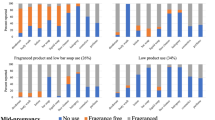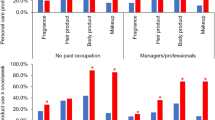Abstract
Personal care product use is a well-established pathway of exposure for notable endocrine disrupting compounds (EDCs), including phthalates, parabens, triclosan, benzophenone-3 (BP3), and bisphenol-A. We utilized questionnaire data from the National Health and Nutrition Examination Survey 2009–2012 cycles to examine the associations between use of sunscreen and mouthwash and urinary concentrations of phthalate metabolites and phenols in a nationally representative population of US adults (n=3529). Compared with individuals who reported “Never” using mouthwash, individuals who reported daily use had significantly elevated urinary concentrations of mono-ethyl phthalate, methyl and propyl parabens, and BP3 (28%, 30%, 39%, and 42% higher, respectively). Individuals who reported “Always” using sunscreen had significantly higher urinary concentrations of triclosan, methyl, ethyl, and propyl parabens, and BP3 (59%, 92%, 102%, 151%, and 510% higher, respectively) compared with “Never” users of sunscreen. Associations between exposure biomarkers and sunscreen use were stronger in women compared with men, and associations with mouthwash use were generally stronger in men compared with women. These results suggest that sunscreen and mouthwash may be important exposure sources for EDCs.
This is a preview of subscription content, access via your institution
Access options
Subscribe to this journal
Receive 6 print issues and online access
$259.00 per year
only $43.17 per issue
Buy this article
- Purchase on Springer Link
- Instant access to full article PDF
Prices may be subject to local taxes which are calculated during checkout

Similar content being viewed by others
References
Borch J, Metzdorff SB, Vinggaard AM, Brokken L, Dalgaard M . Mechanisms underlying the anti-androgenic effects of diethylhexyl phthalate in fetal rat testis. Toxicology 2006; 223: 144–155.
Tetz LM, Cheng AA, Korte CS, Giese RW, Wang P, Harris C et al. Mono-2-ethylhexyl phthalate induces oxidative stress responses in human placental cells in vitro. Toxicol Appl Pharmacol 2013; 268: 47–54.
Krause M, Klit A, Blomberg Jensen M, Søeborg T, Frederiksen H, Schlumpf M et al. Sunscreens: are they beneficial for health? An overview of endocrine disrupting properties of UV‐filters. Int J Androl 2012; 35: 424–436.
Dann AB, Hontela A . Triclosan: environmental exposure, toxicity and mechanisms of action. J Appl Toxicol 2011; 31: 285–311.
Darbre PD, Harvey PW . Paraben esters: review of recent studies of endocrine toxicity, absorption, esterase and human exposure, and discussion of potential human health risks. J Appl Toxicol 2008; 28: 561–578.
Koeppe ES, Ferguson KK, Colacino JA, Meeker JD . Relationship between urinary triclosan and paraben concentrations and serum thyroid measures in NHANES 2007–2008. Sci Total Environ 2013; 445-446: 299–305.
Watkins DJ, Ferguson KK, Anzalota Del Toro LV, Alshawabkeh AN, Cordero JF, Meeker JD . Associations between urinary phenol and paraben concentrations and markers of oxidative stress and inflammation among pregnant women in Puerto Rico. Int J Hyg Environ Health 2014; 218: 212–219.
Hatch EE, Nelson JW, Stahlhut RW, Webster TF . Association of endocrine disruptors and obesity: perspectives from epidemiological studies. Int J Androl 2010; 33: 324–332.
Lang IA, Galloway TS, Scarlett A, Henley WE, Depledge M, Wallace RB et al. Association of urinary bisphenol A concentration with medical disorders and laboratory abnormalities in adults. JAMA 2008; 300: 1303–1310.
Weuve J, Hauser R, Calafat AM, Missmer SA, Wise LA . Association of exposure to phthalates with endometriosis and uterine leiomyomata: findings from NHANES, 1999–2004. Environ Health Perspect 2010; 118: 825.
Vélez MP, Arbuckle TE, Fraser WD . Female exposure to phenols and phthalates and time to pregnancy: the Maternal-Infant Research on Environmental Chemicals (MIREC) Study. Fertil Steril 2015; 103: 1011–1020 e1012.
Meeker JD, Ehrlich S, Toth TL, Wright DL, Calafat AM, Trisini AT et al. Semen quality and sperm DNA damage in relation to urinary bisphenol A among men from an infertility clinic. Reprod Toxicol 2010; 30: 532–539.
Koniecki D, Wang R, Moody RP, Zhu J . Phthalates in cosmetic and personal care products: concentrations and possible dermal exposure. Environ Res 2011; 111: 329–336.
Parlett LE, Calafat AM, Swan SH . Women’s exposure to phthalates in relation to use of personal care products. J Expo Sci Environ Epidemiol 2013; 23: 197–206.
Dodson RE, Nishioka M, Standley LJ, Perovich LJ, Brody JG, Rudel RA . Endocrine disruptors and asthma-associated chemicals in consumer products. Environ Health Perspect 2012; 120: 935–943.
Braun JM, Just AC, Williams PL, Smith KW, Calafat AM, Hauser R . Personal care product use and urinary phthalate metabolite and paraben concentrations during pregnancy among women from a fertility clinic. J Expo Sci Environ Epidemiol 2014; 24: 459–466.
Meeker JD, Cantonwine DE, Rivera-González LO, Ferguson KK, Mukherjee B, Calafat AM et al. Distribution, variability, and predictors of urinary concentrations of phenols and parabens among pregnant women in Puerto Rico. Environ Sci Technol 2013; 47: 3439–3447.
Krause M, Klit A, Blomberg Jensen M, Soeborg T, Frederiksen H, Schlumpf M et al. Sunscreens: are they beneficial for health? An overview of endocrine disrupting properties of UV-filters. Int J Androl 2012; 35: 424–436.
Tibbetts J . Shining a light on BP-3 exposure: sunscreen chemical measured in US population. Environ Health Perspect 2008; 116: A306.
Calafat AM, Ye X, Wong LY, Reidy JA, Needham LL . Urinary concentrations of triclosan in the U.S. population: 2003–2004. Environ Health Perspect 2008; 116: 303–307.
Environmental Working Group. EWG’s Skin Deep Cosmetics Database. Available from http://www.ewg.org/skindeep/. Accessed 22 September 2015.
National Center for Health Statistics (NCHS). Laboratory Procedure Manual: Environmental Phenol. Available from http://www.cdc.gov/nchs/data/nhanes/nhanes_09_10/EPH_F_met_phenols_parabens.pdf. Accessed 5 February 2015.
NCHS. Laboratory Procedure Manual: Phthalate Metabolites. Available from http://www.cdc.gov/nchs/data/nhanes/nhanes_09_10/PHTHTE_F_met.pdf. Accessed 5 February 2015.
NCHS. Laboratory Procedure Manual: Urinary Creatinine. Available from http://www.cdc.gov/NCHS/data/nhanes/nhanes_09_10/ALB_CR_F_met_creatinine.pdf. Accessed 5 February 2015.
NCHS. Sample Person Questionnaire: Oral Health. Available from http://www.cdc.gov/nchs/data/nhanes/nhanes_11_12/ohq.pdf. Accessed 5 February 2015.
NCHS. Sample Person Questionnaire: Dermatology. Available from http://www.cdc.gov/nchs/data/nhanes/nhanes_11_12/deq.pdf. Accessed 5 February 2015.
R Core Team. R: A Language and Environment for Statistical Computing. Available from http://www.R-project.org. Accessed 5 February 2015.
NCHS. Continuous NHANES web tutorial: Survey design factors. Available from http://www.cdc.gov/nchs/tutorials/NHANES/SurveyDesign/intro.htm. Accessed 5 February 2015.
Zota AR, Calafat AM, Woodruff TJ . Temporal trends in phthalate exposures: findings from the National Health and Nutrition Examination Survey, 2001–2010. Environ Health Perspect 2014; 122: 235–241.
US Food and Drug Administration. Over-the-Counter (OTC) Related Federal Register Notices, Ingredient References, and other Regulatory Information. Available from http://www.fda.gov/AboutFDA/CentersOffices/OfficeofMedicalProductsandTobacco/CDER/ucm106368.htm. Accessed 22 September 2015.
Duty SM, Ackerman RM, Calafat AM, Hauser R . Personal care product use predicts urinary concentrations of some phthalate monoesters. Environ Health Perspect 2005; 113: 1530–1535.
Romero-Franco M, Hernández-Ramírez RU, Calafat AM, Cebrián ME, Needham LL, Teitelbaum S et al. Personal care product use and urinary levels of phthalate metabolites in Mexican women. Environ Int 2011; 37: 867–871.
Just AC, Adibi JJ, Rundle AG, Calafat AM, Camann DE, Hauser R et al. Urinary and air phthalate concentrations and self-reported use of personal care products among minority pregnant women in New York city. J Expo Sci Environ Epidemiol 2010; 20: 625–633.
Parlett LE, Calafat AM, Swan SH . Women’s exposure to phthalates in relation to use of personal care products. J Expo Sci Environ Epidemiol 2013; 23: 197–206.
Braun JM, Just AC, Williams PL, Smith KW, Calafat AM, Hauser R . Personal care product use and urinary phthalate metabolite and paraben concentrations during pregnancy among women from a fertility clinic. J Expo Sci Environ Epidemiol 2014; 24: 459–466.
Buckley JP, Palmieri RT, Matuszewski JM, Herring AH, Baird DD, Hartmann KE et al. Consumer product exposures associated with urinary phthalate levels in pregnant women. J Expo Sci Environ Epidemiol 2012; 22: 468–475.
Larsson K, Ljung Bjorklund K, Palm B, Wennberg M, Kaj L, Lindh CH et al. Exposure determinants of phthalates, parabens, bisphenol A and triclosan in Swedish mothers and their children. Environ Int 2014; 73: 323–333.
Cantonwine DE, Cordero JF, Rivera-Gonzalez LO, Anzalota Del Toro LV, Ferguson KK, Mukherjee B et al. Urinary phthalate metabolite concentrations among pregnant women in Northern Puerto Rico: distribution, temporal variability, and predictors. Environ Int 2014; 62: 1–11.
Wright MW, Wright ST, Wagner RF . Mechanisms of sunscreen failure. J Am Acad Dermatol 2001; 44: 781–784.
Acknowledgements
Funding support was provided by that National Institute of Environmental Health Sciences, National Institutes of Health, grant numbers: P42ES017198, R01ES018872, and P30ES017885.
Author information
Authors and Affiliations
Corresponding author
Ethics declarations
Competing interests
The authors declare no conflict of interest.
Additional information
Supplementary Information accompanies the paper on the Journal of Exposure Science and Environmental Epidemiology website
Supplementary information
Rights and permissions
About this article
Cite this article
Ferguson, K., Colacino, J., Lewis, R. et al. Personal care product use among adults in NHANES: associations between urinary phthalate metabolites and phenols and use of mouthwash and sunscreen. J Expo Sci Environ Epidemiol 27, 326–332 (2017). https://doi.org/10.1038/jes.2016.27
Received:
Accepted:
Published:
Issue Date:
DOI: https://doi.org/10.1038/jes.2016.27
Keywords
This article is cited by
-
Asthma and Environmental Exposures to Phenols, Polycyclic Aromatic Hydrocarbons, and Phthalates in Children
Current Environmental Health Reports (2023)
-
Interventions to Reduce Exposure to Synthetic Phenols and Phthalates from Dietary Intake and Personal Care Products: a Scoping Review
Current Environmental Health Reports (2023)
-
Non-persistent exposures from plasticizers or plastic constituents in remote Arctic communities: a case for further research
Journal of Exposure Science & Environmental Epidemiology (2022)
-
Influence of living in the same home on biomonitored levels of consumer product chemicals
Journal of Exposure Science & Environmental Epidemiology (2022)
-
Phenols, Parabens, Phthalates and Puberty: a Systematic Review of Synthetic Chemicals Commonly Found in Personal Care Products and Girls’ Pubertal Development
Current Environmental Health Reports (2022)



